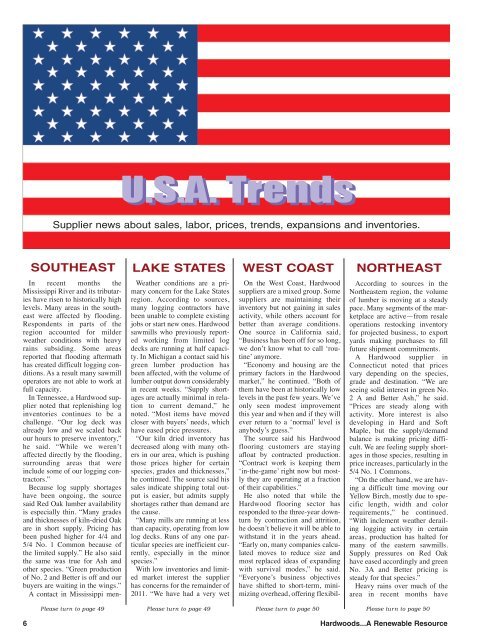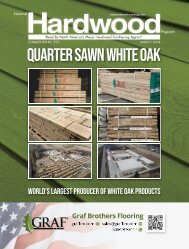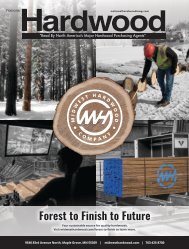National Hardwood Magazine - July 2011
Check out the National Hardwood Magazine's latest issue and stay up-to-date on all the trends, news, and industry info you need.
Check out the National Hardwood Magazine's latest issue and stay up-to-date on all the trends, news, and industry info you need.
You also want an ePaper? Increase the reach of your titles
YUMPU automatically turns print PDFs into web optimized ePapers that Google loves.
Supplier news about sales, labor, prices, trends, expansions and inventories.<br />
SOUTHEAST LAKE STATES WEST COAST<br />
In recent months the<br />
Mississippi River and its tributaries<br />
have risen to historically high<br />
levels. Many areas in the southeast<br />
were affected by flooding.<br />
Respondents in parts of the<br />
region accounted for milder<br />
weather conditions with heavy<br />
rains subsiding. Some areas<br />
reported that flooding aftermath<br />
has created difficult logging conditions.<br />
As a result many sawmill<br />
operators are not able to work at<br />
full capacity.<br />
In Tennessee, a <strong>Hardwood</strong> supplier<br />
noted that replenishing log<br />
inventories continues to be a<br />
challenge. “Our log deck was<br />
already low and we scaled back<br />
our hours to preserve inventory,”<br />
he said. “While we weren’t<br />
affected directly by the flooding,<br />
surrounding areas that were<br />
include some of our logging contractors.”<br />
Because log supply shortages<br />
have been ongoing, the source<br />
said Red Oak lumber availability<br />
is especially thin. “Many grades<br />
and thicknesses of kiln-dried Oak<br />
are in short supply. Pricing has<br />
been pushed higher for 4/4 and<br />
5/4 No. 1 Common because of<br />
the limited supply.” He also said<br />
the same was true for Ash and<br />
other species. “Green production<br />
of No. 2 and Better is off and our<br />
buyers are waiting in the wings.”<br />
A contact in Mississippi men-<br />
Weather conditions are a primary<br />
concern for the Lake States<br />
region. According to sources,<br />
many logging contractors have<br />
been unable to complete existing<br />
jobs or start new ones. <strong>Hardwood</strong><br />
sawmills who previously reported<br />
working from limited log<br />
decks are running at half capacity.<br />
In Michigan a contact said his<br />
green lumber production has<br />
been affected, with the volume of<br />
lumber output down considerably<br />
in recent weeks. “Supply shortages<br />
are actually minimal in relation<br />
to current demand,” he<br />
noted. “Most items have moved<br />
closer with buyers’ needs, which<br />
have eased price pressures.<br />
“Our kiln dried inventory has<br />
decreased along with many others<br />
in our area, which is pushing<br />
those prices higher for certain<br />
species, grades and thicknesses,”<br />
he continued. The source said his<br />
sales indicate shipping total output<br />
is easier, but admits supply<br />
shortages rather than demand are<br />
the cause.<br />
“Many mills are running at less<br />
than capacity, operating from low<br />
log decks. Runs of any one particular<br />
species are inefficient currently,<br />
especially in the minor<br />
species.”<br />
With low inventories and limited<br />
market interest the supplier<br />
has concerns for the remainder of<br />
<strong>2011</strong>. “We have had a very wet<br />
On the West Coast, <strong>Hardwood</strong><br />
suppliers are a mixed group. Some<br />
suppliers are maintaining their<br />
inventory but not gaining in sales<br />
activity, while others account for<br />
better than average conditions.<br />
One source in California said,<br />
“Business has been off for so long,<br />
we don’t know what to call ‘routine’<br />
anymore.<br />
“Economy and housing are the<br />
primary factors in the <strong>Hardwood</strong><br />
market,” he continued. “Both of<br />
them have been at historically low<br />
levels in the past few years. We’ve<br />
only seen modest improvement<br />
this year and when and if they will<br />
ever return to a ‘normal’ level is<br />
anybody’s guess.”<br />
The source said his <strong>Hardwood</strong><br />
flooring customers are staying<br />
afloat by contracted production.<br />
“Contract work is keeping them<br />
‘in-the-game’ right now but mostly<br />
they are operating at a fraction<br />
of their capabilities.”<br />
He also noted that while the<br />
<strong>Hardwood</strong> flooring sector has<br />
responded to the three-year downturn<br />
by contraction and attrition,<br />
he doesn’t believe it will be able to<br />
withstand it in the years ahead.<br />
“Early on, many companies calculated<br />
moves to reduce size and<br />
most replaced ideas of expanding<br />
with survival modes,” he said.<br />
“Everyone’s business objectives<br />
have shifted to short-term, minimizing<br />
overhead, offering flexibil-<br />
NORTHEAST<br />
According to sources in the<br />
Northeastern region, the volume<br />
of lumber is moving at a steady<br />
pace. Many segments of the marketplace<br />
are active—from resale<br />
operations restocking inventory<br />
for projected business, to export<br />
yards making purchases to fill<br />
future shipment commitments.<br />
A <strong>Hardwood</strong> supplier in<br />
Connecticut noted that prices<br />
vary depending on the species,<br />
grade and destination. “We are<br />
seeing solid interest in green No.<br />
2 A and Better Ash,” he said.<br />
“Prices are steady along with<br />
activity. More interest is also<br />
developing in Hard and Soft<br />
Maple, but the supply/demand<br />
balance is making pricing difficult.<br />
We are feeling supply shortages<br />
in those species, resulting in<br />
price increases, particularly in the<br />
5/4 No. 1 Commons.<br />
“On the other hand, we are having<br />
a difficult time moving our<br />
Yellow Birch, mostly due to specific<br />
length, width and color<br />
requirements,” he continued.<br />
“With inclement weather derailing<br />
logging activity in certain<br />
areas, production has halted for<br />
many of the eastern sawmills.<br />
Supply pressures on Red Oak<br />
have eased accordingly and green<br />
No. 3A and Better pricing is<br />
steady for that species.”<br />
Heavy rains over much of the<br />
area in recent months have<br />
Please turn to page 49 Please turn to page 49<br />
Please turn to page 50<br />
Please turn to page 50<br />
6 <strong>Hardwood</strong>s...A Renewable Resource


















